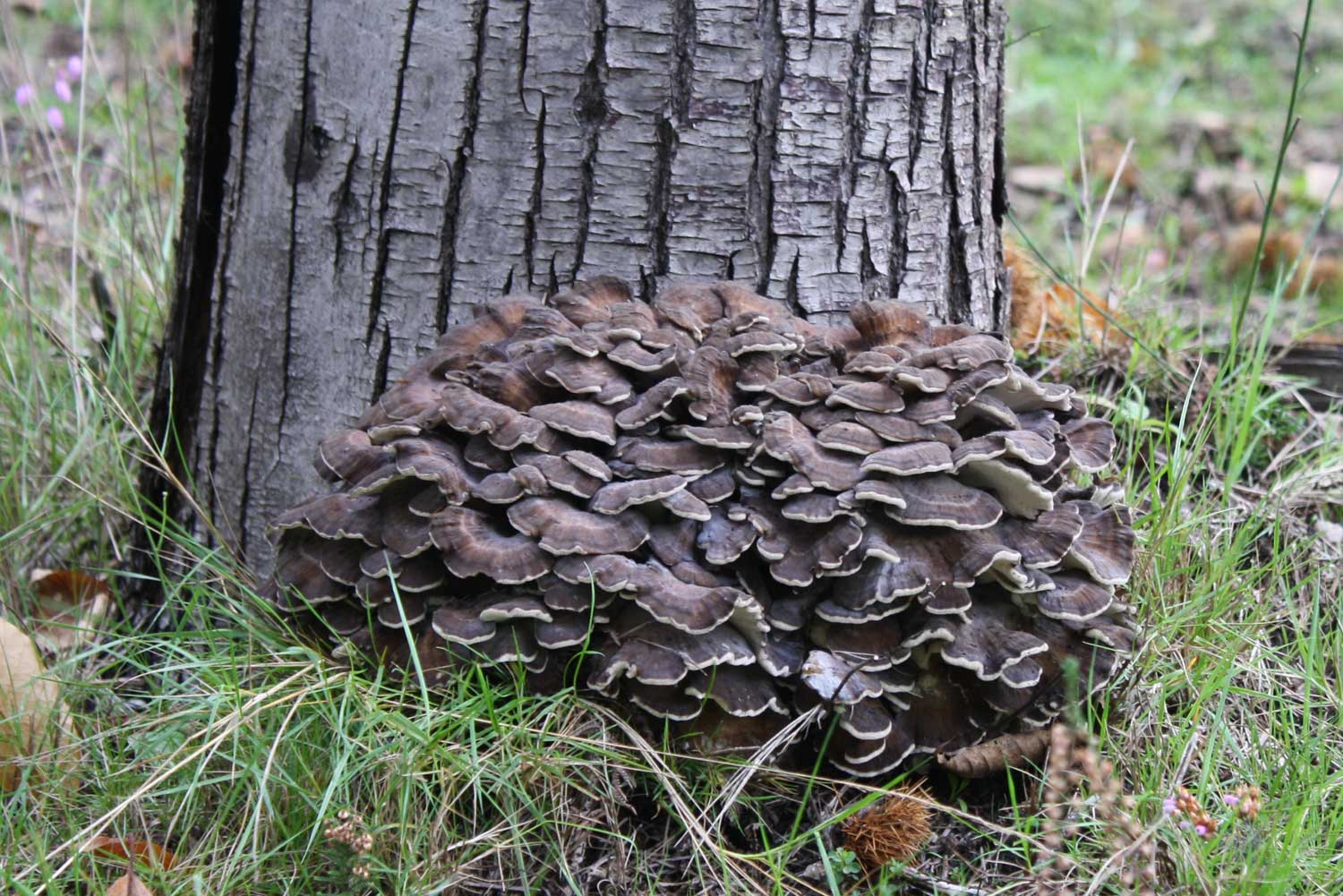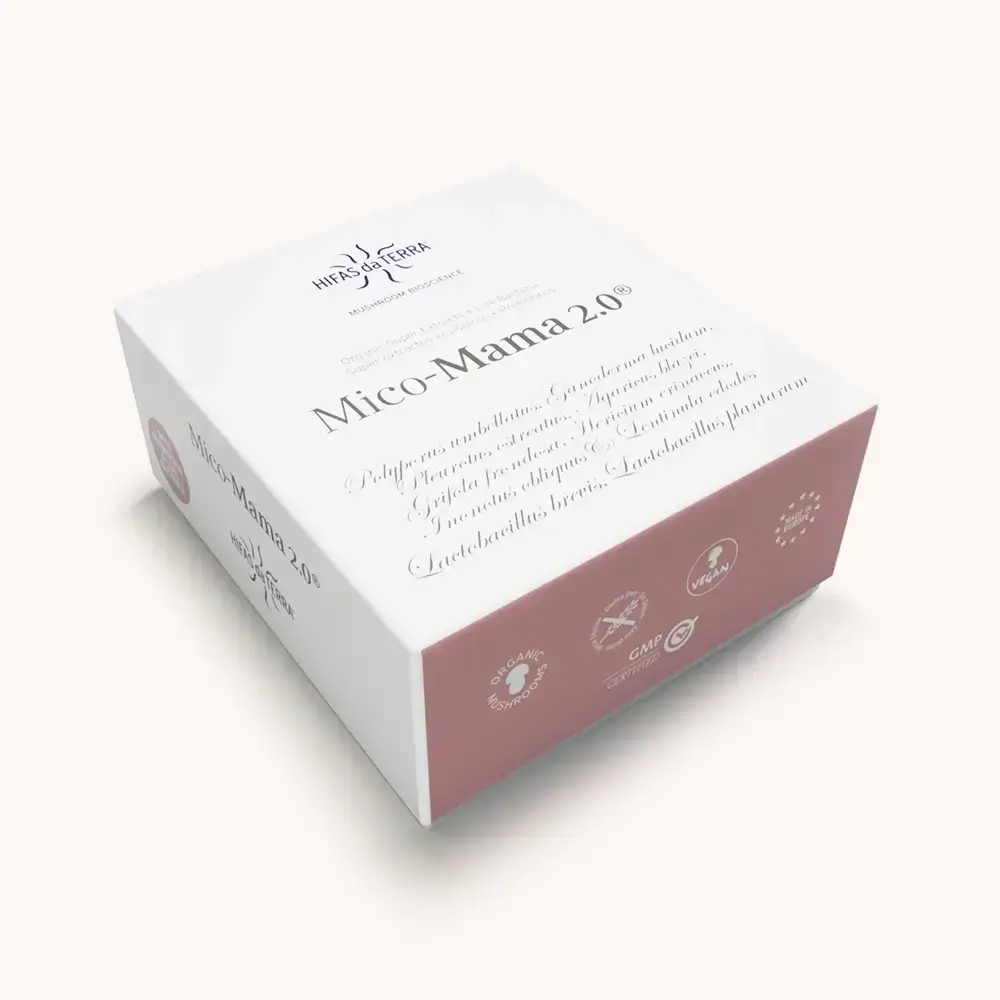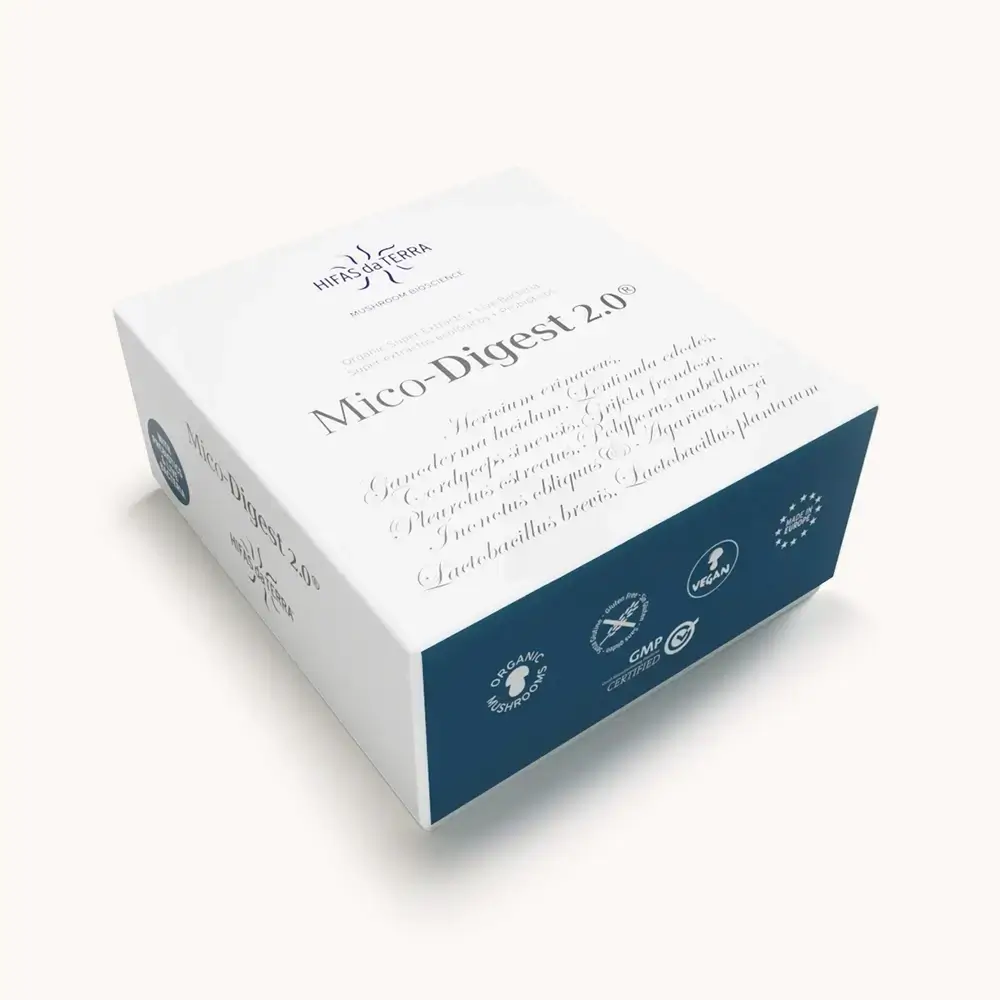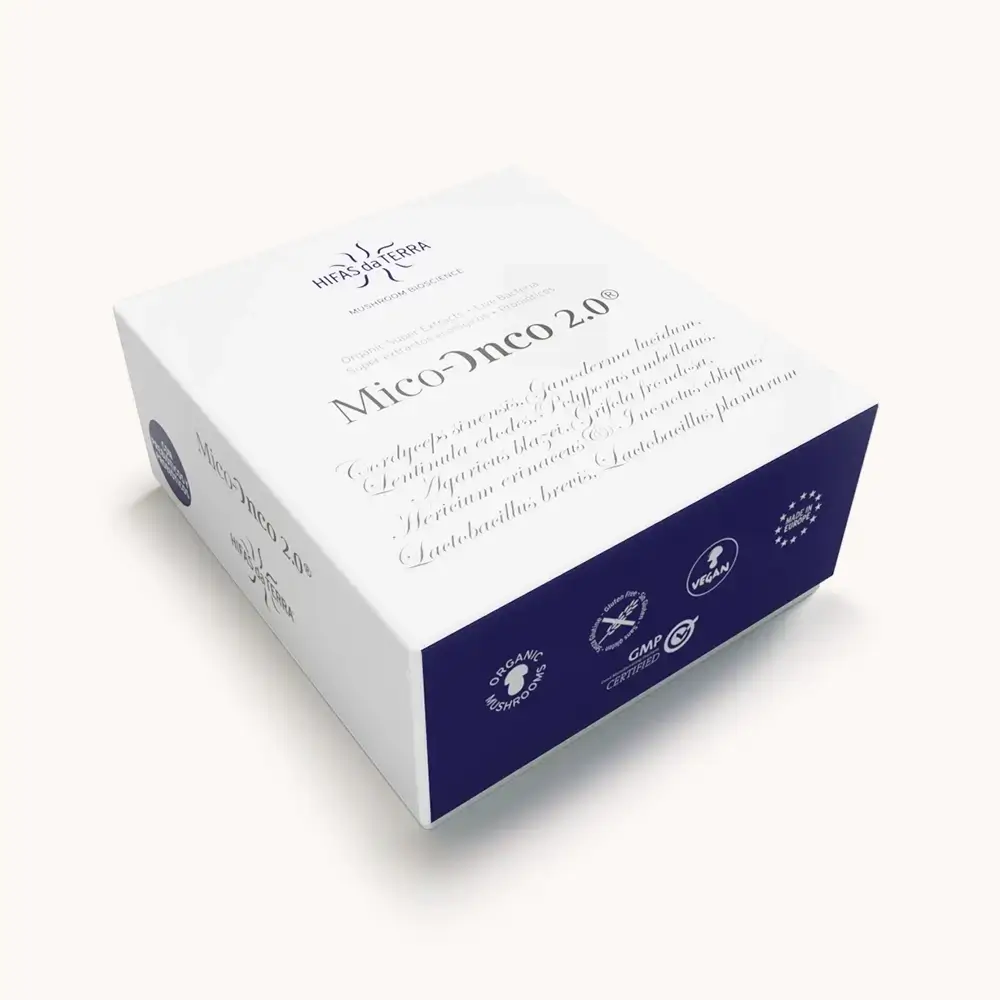Maitake, known by its scientific name Grifola frondosa, is one of the most popular medicinal mushrooms as part of the triad of Reishi, Maitake and Shiitake, used in traditional Chinese medicine as health tonics and excellent adaptogens. Grifola is a popular edible in China and Japan, where it has also been used for medicinal purposes for centuries. Popular names include ‘Hen of the Woods’, ‘Sheepshead’, ‘River Mushroom’ or ‘Hui zhu hua’.
ESSENTIAL NOTES ON THE ‘DANCING MUSHROOM’
G. frondosa contains beta-glucans, immunomodulators of fungal origin, whose structure is more complex than those present in cereals such as oats. This structure is directly related to its actions. Maitake also contains lectins, enzymes, provitamin D, vitamins ーespecially B vitaminsー and important minerals such as magnesium, phosphorus and potassium. Its nutritional profile is very interesting, as are its bioactive molecules, which are essential for many biological functions. For this reason, its possible applications in the following areas of study are being investigated:
- Metabolic-endocrine: especially in weight control, detox and cardiovascular health indicators (cholesterol, triglycerides, hypertension).
- Integrative support: studies on its activity in combination with conventional treatments and its effect on quality of life.
In traditional Asian medicine, Maitake is particularly indicated to “tonify the spleen-pancreas meridian and its complementary stomach meridian”.

PROPERTIES, APPLICATIONS AND USES OF MAITAKE
Maitake, along with Reishi and Shiitake, is a medicinal mushroom of interest for its nutritional composition. This species can be consumed as food, the simplest – but also least concentrated – way of incorporating its nutrients into the body. For the best use of its qualities, the most concentrated form is Maitake extract. Through a natural process, its active biomolecules can be concentrated to obtain an extract that can be consumed in capsules on its own (Mico-Mai) or combined with other species (Mico-Mix and Mico-Five). Other forms are obtained by dehydrating and grinding the fruiting body of the mushroom. This is colloquially known as ‘micronised powder’ (Bio-Defense) and, although it has a lower concentration of bioactive substances than the extract, it can be useful in supporting the body’s defences.
PROPERTIES, APPLICATIONS AND USES OF MAITAKE
Maitake, along with Reishi and Shiitake, is a medicinal mushroom of interest for its nutritional composition. This species can be consumed as food, the simplest – but also least concentrated – way of incorporating its nutrients into the body. For the best use of its qualities, the most concentrated form is Maitake extract. Through a natural process, its active biomolecules can be concentrated to obtain an extract that can be consumed in capsules on its own (Mico-Mai) or combined with other species (Mico-Mix and Mico-Five). Other forms are obtained by dehydrating and grinding the fruiting body of the mushroom. This is colloquially known as ‘micronised powder’ (Bio-Defense) and, although it has a lower concentration of bioactive substances than the extract, it can be useful in supporting the body’s defences.
PRODUCTS WITH MAITAKE
£262.00
£262.00
£250.00
£64.90
£228.00
£34.00 Original price was: £34.00.£30.60Current price is: £30.60.
NUTRIENT HIGHLIGHTS
In R&D we research the active biomolecules of this fungus. This species possesses nutrients of functional interest, including substances such as:
HABITAT AND DISTRIBUTION
Maitake grows worldwide in deciduous forests in temperate climates. This medicinal mushroom grows naturally on stumps of old oak trees, but also chestnut, beech and lime trees.
G. frondosa is widely distributed in temperate areas of the northern hemisphere, ranging from Europe to northern North America, Japan and China.
In the early stages of its development, this species is soft and suitable for cooking; however, as it matures, it acquires a woody consistency, which makes it difficult to consume as food. Given these circumstances, it is usually consumed for its functional interest via food supplements.
MYCOLOGICAL NOTES
This mushroom belongs to the order Poriales, family Poriaceae and genus Grifola, which includes two species: G. frondosa and G. umbellata.
The Japanese name Maitake literally means ‘Dancing Mushroom’, which may be due to its peculiar shape. Maitake is composed of a set of small carpophores welded together, giving it the appearance of a well-ordered floral cluster on an axis. Their overlapping, greyish-brown caps form a fan-shaped mosaic as in traditional Japanese dances.
This mushroom is typical of autumn, appearing with the arrival of the first rains on cut tree stumps. Its fruiting body is very large, weighing up to 20 kg and reaching 60 cm in height.
Its flesh is soft with a flour-like smell; the stalk when emerging from the base of a tree takes on a sideways, branched, white and dark appearance at the base.
MAITAKE CULTIVATION
As mentioned above, it is a medicinal fungus that grows mainly on old or inert chestnut or oak trees.
Outdoor cultivation is quite complex, so it is usually done by inoculating cut hardwood stumps. It is also possible to inoculate the trunks of these trees by subsequently burying them to maintain the required moisture levels.
Another way of cultivating this fungus is in perforated sacks using sterilised sawdust and rice flour as substrate. Some authors refer to its cultivation on pine trees. Although not common, this could be related to Paul Stamets’ theory that this species appeared on conifer stumps.
Although Maitake is still relatively unknown in Europe, it is considered a very popular edible mushroom in Asia, especially in Japan. Cultivation techniques for this mushroom were perfected in the 1970s.
Highest quality, purity and perfomance in our production systems
Through our own quality standards, we identify biomolecules and active ingredients with therapeutic actions, selecting the fungal strains that contain the optimum amounts, and use our own specific analytical systems to apply analysis protocols at different stages of production. Thanks to this rigorous system, we offer natural products, supplements and nutraceuticals with the Hifas Quality System guarantee, setting us apart from other products in terms of quality, safety and efficacy.

Highest quality, purity and performance in our production systems.
Through our own quality standards, we identify biomolecules and active ingredients with therapeutic actions, selecting the fungal strains that contain the optimum amounts, and use our own specific analytical systems to apply analysis protocols at different stages of production. Thanks to this rigorous system, we offer natural products, supplements and nutraceuticals with the Hifas Quality System guarantee, setting us apart from other products in terms of quality, safety and efficacy.
MAITAKE R&D AND STUDIES
- Within the framework of the FungiTechOnco project, HdT researchers have identified three indigenous strains of Maitake, and are now able to carry out a study on their activity.
- A study by Hifas da Terra carried out on cell lines with Maitake extracts shows it could compromise the progression of metastasis in colorectal cancer.
FUN FACTS
- Some taxonomists believe that the name Grifola is derived from Grifone, a mythological animal with the head and wings of an eagle, but with the legs and tail of a lion. Frondosa means ‘leaf-shaped’, as the fruiting body has the appearance of overlapping leaves.
- In Japan, it is known as the ‘dancing mushroom’ because, in ancient times, whoever found a specimen would dance for joy, thinking of the profit he would make from his discovery. According to Japanese texts, the Samurai were the main buyers of this species because of its qualities.
- Fukushima M, Ohashi T, Fujiwara Y, Sonoyama K, Nakano M. Cholesterol-lowering effects of maitake (Grifola frondosa) fiber, Shiitake (Lentinus edodes) fiber, and enokitake (Flammulina velutipes) fiber in rats. Exp Biol Med (Maywood). 2001 Sep;226(8):758-65.
- Kawai J, Higuchi Y, Hirota M, Hirasawa N, Mori K. Ergosterol and its derivatives from Grifola frondosa inhibit antigen-induced degranulation of RBL-2H3 cells by suppressing the aggregation of high affinity IgE receptors. Biosci Biotechnol Biochem. 2018 Jul 2;:1-9. PubMed PMID: 29968517.
- Kou L, Du M, Liu P, Zhang B, Zhang Y, et al. Anti-Diabetic and Anti-Nephritic Activities of Grifola frondosa Mycelium Polysaccharides in Diet-Streptozotocin-Induced Diabetic Rats Via Modulation on Oxidative Stress. Appl Biochem Biotechnol. 2018 Jun 26;PubMed PMID: 29943275.
- Li Q, Chen G, Wang W, Zhang W, Ding Y, et al. A novel Se-polysaccharide from Se-enriched G frondosa protects against immunosuppression and low Se status in Se-deficient mice. Int J Biol Macromol. 2018 Oct 1;117:878-889. PubMed PMID: 29807076.
- Li Q, Chen G, Chen H, Zhang W, Ding Y, et al. Se-enriched G frondosa polysaccharide protects against immunosuppression in cyclophosphamide-induced mice via MAPKs signal transduction pathway. Carbohydr Polym. 2018 Sep 15;196:445-456. PubMed PMID: 29891317.
- Liu S, Zhuang X, Zhang X, Han W, Liu Y, et al. Enzymatic Modification of Rice Bran Polysaccharides by Enzymes from Grifola Frondosa: Natural Killer Cell Cytotoxicity and Antioxidant Activity. J Food Sci. 2018 Jul;83(7):1948-1955. PubMed PMID: 29939404.
- Nishihira, J., Sato, M., Tanaka, A., Okamatsu, M., Azuma, T., Tsutsumi, N., & Yoneyama, S. (2017). Maitake mushrooms (Grifola frondosa) enhances antibody production in response to influenza vaccination in healthy adult volunteers concurrent with alleviation of common cold symptoms. Functional Foods in Health and Disease, 7(7), 462-482.
Maitake
Grifola frondosa
HEN OF THE WOODS (HEN OF THE WOODS)
Sheep’s Head (Sheep’s Head)
KAWARATAKE (RIVER MUSHROOM)
Hui zhu hua








